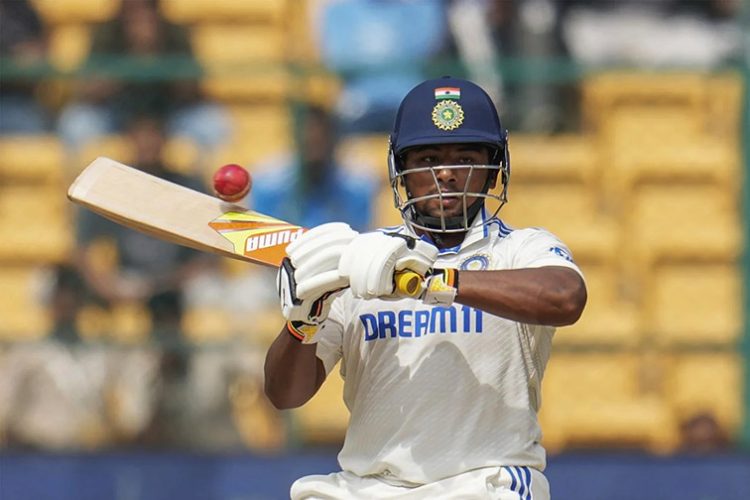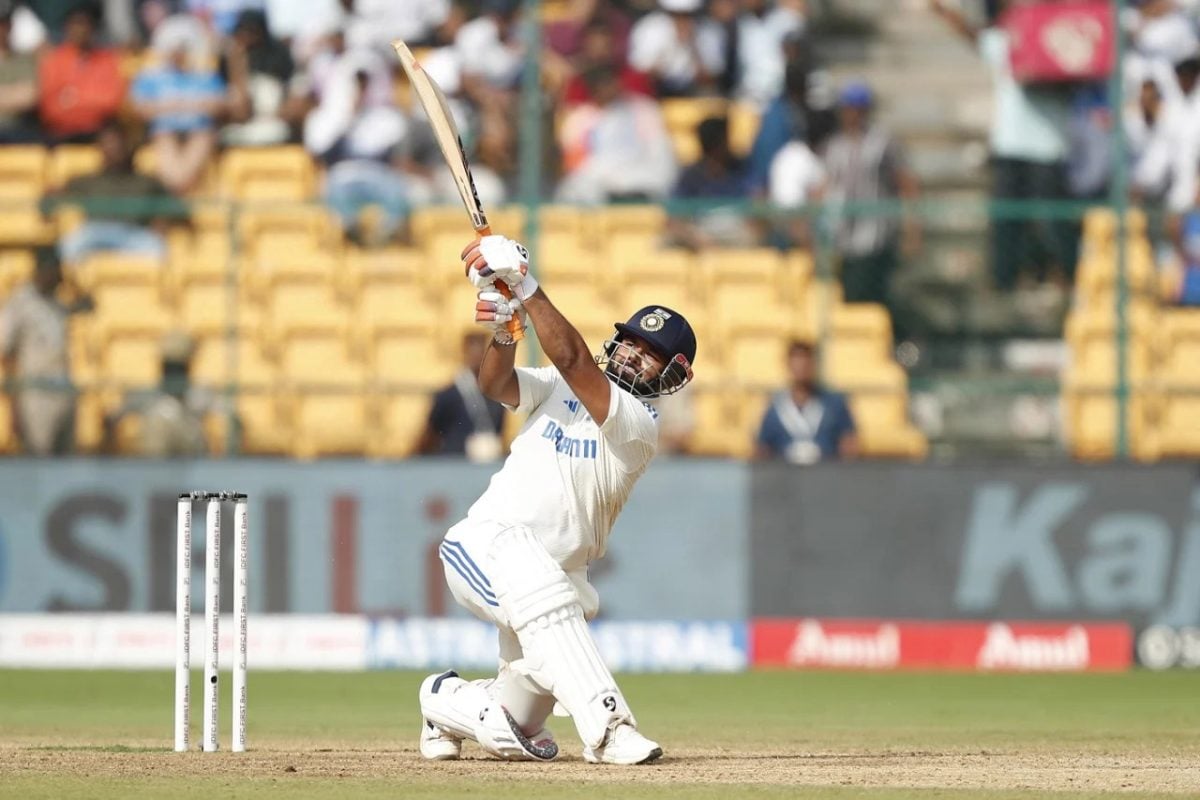(ESPN Cricinfo) – Test cricket showed off in all its glory as India, led by the impish Sarfaraz Khan and Rishabh Pant, threatened to pull off the unthinkable in an audacious manner.
But the second new ball claimed seven wickets for 62 runs to leave New Zealand 107 to win their first Test in India in 36 years. That, incidentally, is the lowest target successfully defended in India, but that was on a rank-turner in Mumbai in 2004-05.
This was Test cricket shorn of all of its niceties. The bowlers were under extreme pressure from Sarfaraz and Pant, who added 177 in 35.1 overs, as India tried to become only the second team to win a Test from a sub-50 first innings. This same approach resulted in a collapse when the second new ball started to nip around.
This was high-variance Test cricket. India lost 17 wickets for 108 runs to the first and the third new balls but scored 400 for 3 in 80 overs in between.

wicketkeeper during his innings of 150 (ESPN Cricinfo Photo).
India’s quick scoring rate meant the second new ball was New Zealand’s absolute last roll of the dice. Had they failed to cause any damage with the new ball, the best they could have hoped for was a draw. Keeping in mind how they had been pummelled and made to look toothless for 80 overs, it was a show of remarkable skill and persistence to roar back into the match.
In under 20 overs, they drew 43 false shots from India, having done so only 72 times in the first 80 overs. Much of it was down to Sarfaraz swinging his bat, hoping to blast the new ball, but who dare question that approach when he scored 150, showing similarly scant regard to the bowling. Pant himself tried to hit his way out, gloving a sweep off Tim Southee, slog-sweeping him out of the stadium, but then playing on the 6’6” Will O’Rourke with the replacement ball on 99, his seventh dismissal in the 90s to go with six hundreds.
O’Rourke was fiery, 3-3-0-3 at one point with the new ball, before Matt Henry found just the optimum seam to take out the last three. It showed just how far you fall behind when you get bowled out for 46. Sarfaraz and Pant carried on from the 231 for 3 on day three and managed to one-up the progress. Teammates at the Under-19 World Cup, they were innovative and thrilling.
Sarfaraz turned his first Test hundred into a 150, his 11th first-class score of 150 or more out of his 16 hundreds. Pant, who missed keeping duties after a knock on his surgically repaired knee from his life-threatening road accident, matched him in audacity. However, with his running hampered, he turned at least two couples into singles as he approached the hundred. He walked back with a wistful look at the sky.
If Sarfaraz toyed with the bowling with late-cuts and ramps while ducking and weaving, Pant slog-swept fast bowlers and charged at them to hit them past mid-off. His five sixes took him past Kapil Dev and placed him sixth in the list of top six-hitters for India in Tests.
Before the new ball, the only time New Zealand came close to a wicket was a run-out opportunity at Pant’s end, but Tom Blundell reprieved him for the second time in the match by leaving his base to collect a wide throw, seemingly unaware of the opportunity at his end. Pant was on only 6 then.
As Pant felt his way into the innings, scoring 12 off the first 24 balls he faced, Sarfaraz took only six balls in the morning to bring out his cheekiness: a nonchalant ramp off O’Rourke’s first ball of the day. When they reinforced the field with a deep third and a deep point, Sarfaraz still bisected them.
Soon Pant joined him. They showed little regard for the field sets and no fear of making mistakes, and the New Zealand bowlers again failed to provide Tom Latham with any control. The biggest disappointment was Ajaz Patel, who turned the ball less than the part-timer Rachin Ravindra.
It seemed the seam bowlers wanted to trap Sarfaraz lbw, but that only kept giving him easy singles on the leg side. When the keeper came up to the stumps to root Pant to the crease, the visitors were rewarded with an edge, but the dying pitch didn’t have enough in it to make it carry. Soon, though, he lofted Southee from the crease for a six back over his head.
In the eighth over of the day, Sarfaraz punched Southee to deep cover for what would have been a single for any other batter, but he had sent all the fielders elsewhere with his late-cuts. The boundary brought up an emotional hundred.
When Ajaz got one to kick at Pant from the rough, the glove absorbed a lot of the impact, and the ball went straight down. He now decided he had to attack. In one dramatic Ajaz over, he hit two sixes. Then he survived an inside edge and an outside edge in the same over. The inside one saved him from lbw, and his back pad denied New Zealand a catch off the outside edge. Pant still managed to hit one more four in the over, India’s 47th boundary, more than the runs they scored in the first innings.
A shower brought them some relief, but India kept attacking before the new ball, taking their run rate back up to five per over. At first, it appeared New Zealand had exhausted all their luck in getting the conditions to bowl India out for 46 and in getting Rohit Sharma out in the second innings. For now, everything just started going past the bat or falling safe.
Sarfaraz survived seven various kinds of false shots before he finally lobbed one to cover as the ball seamed away from him. Pant, not quite at home himself against the new ball, tried a sweep before actually dropping jaws on the floor with the slog-swept six to go into the 90s.
Then came O’Rourke, who had been ramped for four first ball in the morning. This time, his first ball nipped back and kicked at Pant to take the fatal bottom edge to silence the crowd. His extra bounce and seam movement away also accounted for KL Rahul. Then one came slowly off the surface to take the toe end on a Ravindra Jadeja pull.
Henry bowled an unbroken ten-over spell to keep a lid on the scoring and take the last three wickets to go with his first innings’ five. While the India fans had gone from praying for the rain to stop to now hoping for biblical thunderstorms, India didn’t seem pleased when they were asked to go off early for bad light, which did later turn into a massive storm.
The new ball was moving, and India was hoping for some damage under artificial lights.

